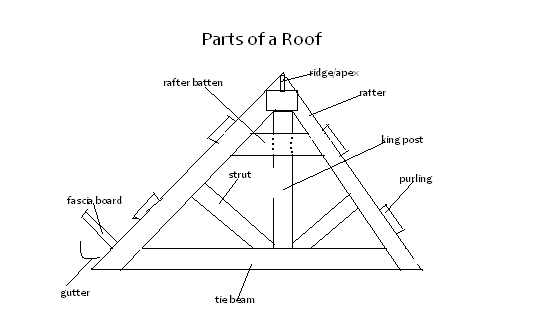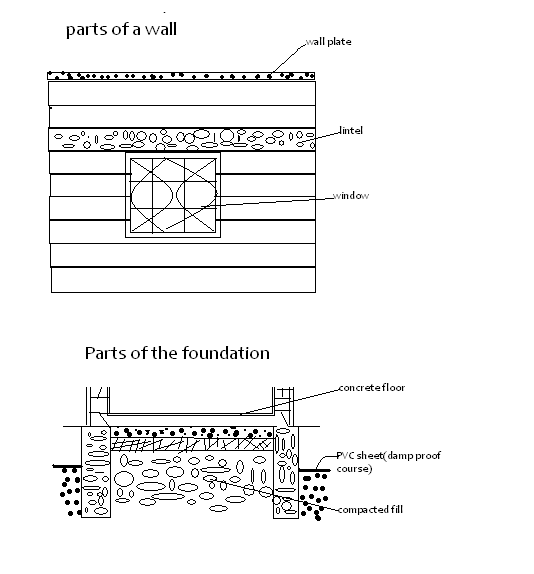Introduction
- Farm structures are physical constructions on the farm used to increase efficiency in production.
Construction of Farm Structures
Involves:
Planning for farm structures ;
Consider;
- Farm activities.
- Size of the enterprise.
- Future of the enterprise.
- Accessibility.
- Soil type.
Siting farm structures;
Consider:
- The location of the homestead.
- Accessibility.
- Security.
- Drainage/topography.
- Wind direction.
- Relationship between the structures.
- Proximity to social amenities.
- Farmer’s taste and preference.
Materials for Construction
Structural Materials and Use
Factors which determine the type of materials to use are;
- durability,
- strength,
- labour,
- availability,
- workability,
- serviceability,
- cost
Stones and Bricks
Advantages
- Stones and bricks are durable, easy to disinfect, resistant to weather and insects decay and are easily available.
Disadvantages
- They are bulky and require skilled labour to make them.
Plastic and Synthetic Materials
These include;
- glass,
- asbestos fibre
- polythene materials.
Advantages
- Light,
- cheep depending on quality,
- easy to disinfect,
- can be moulded into any shape,
- are durable,
- cannot be destroyed by insects and fungus
- are water-proof.
Disadvantages
- Are easily destroyed,
- fragile,
- very expensive
- require skilled labour.
Wood (Timber)
Advantages
- They are workable,
- cheap,
- can be re-used
- are fairly strong.
Disadvantages
- They can catch fire easily,
- decay if exposed to water
- are affected by fungus and insects.
Concrete
- Is a mixture of cement, sand, aggregate and water
- e.g. in making blocks the ratio is 1:2:3; one part cement, two parts sand and three parts aggregate.
Uses
- Making posts for fencing.
- Making walls and floor of buildings.
- Making gabions and water channels to prevent erosion.
- Making water troughs.
Advantages
These materials are;
- durable, workable,
- easy to disinfect,
- cheap to maintain,
- fire resistant
Disadvantages
- These materials are ;
- expensive,
- require skilled labour,
- bulky,
- cannot be reused
Animal handling structures
- The crush –used when doing following activities;
- Spraying livestock to control ticks,
- milking,
- examining sick animals,
- artificial insemination,
- treating animals, eg drenching, vaccination,
- dong routine jobs such as dehorning, identification marks,
- The spray race-used in the control of ticks by spraying livestock with acaricides
- The dip- machakos type, and the pludge dip. This is used in the control of ticks by dipping livestock
Farm Buildings
Factors to be considered in site selection;
- Security
- Nearness to a source of water
- Topography
- Direction of the prevailing wind
- Direction of the sun
- Personal whims/tastes and preference
- Nearness to means of communication.
Types of farm buildings
- Houses for farm animals.
- Stores for farm produce.
- Stores for equipment, tools and supplies.
- Buildings for growing crops e.g green house.
- Building for processing plant e.g milk plant.
Parts of a building
- The foundation,
- The walls,
- The roof

Include;
- kingpost,
- rafters,
- struts,
- tie beam,
- rafter batten

Include;
- concrete floor,
- foundation wall,
- PVC sheet (damp-proof course)
- the compacted fill (hard core).
Fences
- Importance of Fence in a Farm
- Keep out intruders to the farm,
- Define the boundary lines of the farm.
- Paddocking of fields to make rotational grazing possible.
- Live fences serve as windbreaks.
- Fences are used in mixed farming to protect crops from. damage by livestock.
- Fences add aesthetic values to the farm.
- It is easy to control breeding.
- It is easy to isolate sick animals from the rest of the herd.
Types of Fences
- Dead fences.
- Barbed wire fences.
- Electric fence.
- Concrete fence.
- Chicken wire fence (mesh wire fence).
- Woven wire fence (chain link).
- Wooden fence.
Fencing Practice
Materials include;
- wires,
- staples,
- nails,
- posts,
- droppers
- concrete materials.
- Size of posts:
- General purpose 2.5m by 25cm in diameter
- Strainer units and corner posts 3m by 30cm in diameter:
- Distance between the posts:
- 3m between posts, 10m if droppers are to be used.
- 200m between strainer units.
- Depth of holes – 60cm.
Gate Posts, Gates and Strainer Units
- Gates should be hung on posts separate from the fence.
- Mechanical implements for example tractors require 4.0-4.5m width of gate.
- Entrance gates for pedestrians can be accommodated within the fence.
Steps in Fencing
- Locate the corners
- Clear the fencing area.
- Mark gates, strainers, pass places and standards by pegging.
- Dig holes to proper depths.
- Fix the standard posts.
- Firm around posts or apply concrete.
- Fix wires on posts.
- Fix the droppers.
